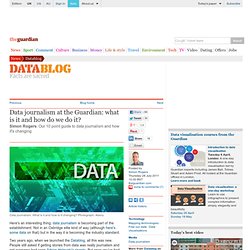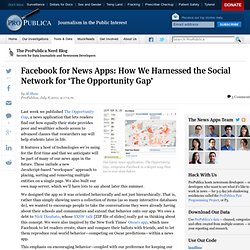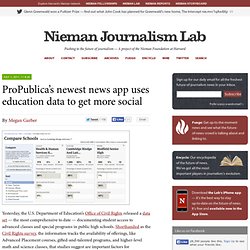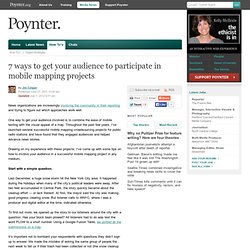

Data journalism at the Guardian: what is it and how do we do it? Data journalism.

What is it and how is it changing? Photograph: Alamy Here's an interesting thing: data journalism is becoming part of the establishment. Not in an Oxbridge elite kind of way (although here's some data on that) but in the way it is becoming the industry standard. Two years ago, when we launched the Datablog, all this was new. Meanwhile every day brings newer and more innovative journalists into the field, and with them new skills and techniques.
These are some of the threads from my recent talks I thought it would be good to put in one place - especially now we've got an honourable mention in the Knight Batten award for journalistic innovation. 1. Florence Nightingale's 'coxcomb' diagram on mortality in the army Data journalism has been around as long as there's been data - certainly at least since Florence Nightingale's famous graphics and report into the conditions faced by British soldiers of 1858. The big difference? 2. 3. Sometimes. 4. Read more about this map 5. 6. Blog, 25 great links for data-lovin' journalists. Facebook for News Apps: How We Harnessed The Social Network for ‘The Opportunity Gap’ Our latest news application, The Opportunity Gap, integrates Facebook in a deeper way than we've ever done before.

Last week we published The Opportunity Gap, a news application that lets readers find out how equally their state provides poor and wealthier schools access to advanced classes that researchers say will help students later in life. It features a host of technologies we’re using for the first time and that we anticipate will be part of many of our news apps in the future. These include a new JavaScript-based “workspace” approach to placing, sorting and removing multiple entities on a single page. We also built our own map server, which we’ll have lots to say about later this summer. We designed the app so it was oriented behaviorally and not just hierarchically. This emphasis on encouraging behavior—coupled with our preference for keeping our apps light on database writes—spurred us to integrate Facebook in a deeper way than we’ve done before. Facebook As a Relevance Engine.
ProPublica’s newest news app uses education data to get more social. ProPublica reporters used the Ed data to produce a story package, “The Opportunity Gap,” that analyzes the OCR info and other federal education data; their analysis found among other things that, overall and unsurprisingly, high-poverty schools are less likely than their wealthier counterparts to have students enrolled in those beneficial programs.

The achievement gap, the data suggest, isn’t just about students’ educational attainment; it’s also about the educational opportunities provided to those students in the first place. And it’s individual states that are making the policy decisions that affect the quality of those opportunities. ProPublica’s analysis, says senior editor Eric Umansky, is aimed at answering one key question: “Are states giving their kids a fair shake?” ProPublica leads the field in developing news apps; each one demands a unique strategy for determining how users will actually navigate — and benefit from — the app’s interface. ProPublica's data journalism goes social. 7 ways to get your audience to participate in mobile mapping projects.
News organizations are increasingly involving the community in their reporting and trying to figure out which approaches work well.

One way to get your audience involved is to combine the ease of mobile texting with the visual appeal of a map. Throughout the past few years, I’ve launched several successful mobile mapping crowdsourcing projects for public radio stations and have found that they engaged audiences and helped advance news stories. Drawing on my experience with these projects, I’ve come up with some tips on how to involve your audience in a successful mobile mapping project in any medium. Start with a simple question. Last December, a huge snow storm hit the New York City area. To find out more, we opened up the story to our listeners around the city with a question: Has your block been plowed? It’s important not to bombard your respondents with questions they didn’t sign up to answer. Integrate examples seamlessly with other content. Be ready for breaking news.